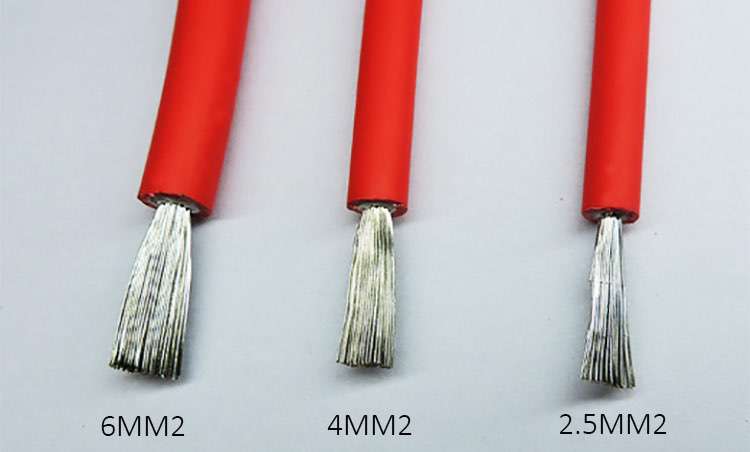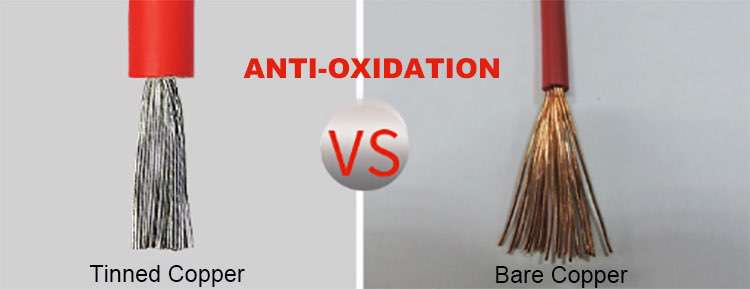 Author: Joey Wan
Author: Joey Wan  December 28,2021
December 28,2021
Photovoltaic cables are one of the most important accessories for solar power generation. Moreover, there are many steps involved in wiring, among which it is more important to choose the correct solar cable size; what size should a suitable photovoltaic cable be? You might worry about this. Choosing the right photovoltaic cable size for your photovoltaic panel system can promote safe operation and use. Maybe it will cost you 9 minutes to read such article because of a little long.
In general, if the size of the photovoltaic cable is too small, some accidents may occur. For example, the high temperature of the wire and cable may cause a fire. Therefore, here we will discuss some issues on how to choose the size of the photovoltaic cable.

1. The standard units of photovoltaic cable size are mm2 and AWG. There are different sizes and different wire gauge sizes. Different sizes will directly affect the laying operation.
2. Generally speaking, the higher the number of specifications, the greater the resistance of the photovoltaic cable, and the lower the current it can safely handle.
3. In addition, different wire diameters are required for different purposes. For example, the photovoltaic cable used to connect to the battery pack may require a different size than the wire used to connect to the charger controller. It can vary according to the type of your solar system. Residential solar systems and commercial systems require different wire sizes.
What is the size of photovoltaic cable exactly?
As we all know, there are many components in a solar panel system, including solar panels, batteries, charge controllers and inverters. To build a complete solar system, you need to use photovoltaic cables to connect them together to form a circuit. Wires carry current, and current can flow from or to certain components through the wire.
The photovoltaic cable size is the diameter and length of the guide wire. If the diameter of the wire is large, its resistance will be small, and the current will be smooth and safe. On the contrary, the resistance will be large and hinder the flow. Similarly, if the length is too long, the resistance will rise, which may cause difficulty in current flow.
Understand the normal residential use of photovoltaic cable sizes and their corresponding ampere rated voltage values. Or let's take some of them as examples.
| 3/0 awg | 200 amps |
| 1/0 awg | 150 amps |
| 3 awg | 100 amps |
| 6 awg | 55 amps |
| 8 awg | 40 amps |
| 10 awg | 30 amps (suitable for dryers, electrical appliances and air conditioners) |
| 12 awg | 20 amps (applicable to electrical appliances, laundry rooms and bathroom circuits) |
| 14 awg | 15 amps (suitable for general lighting and socket circuits) |
How to determine the various wire diameters of each component of the photovoltaic system? Before calculating the various parts of the solar system, you should understand a few terms.
1. Voltage: Voltage refers to the potential difference, which refers to the potential difference between the two ends of the circuit. It is expressed as "V" in the equation and is evaluated in volts (V).
2. Voltage drop index: When the wire size is too small, the voltage will drop, resulting in wire voltage drop and power loss. This reduced index is called the pressure drop index.
3. Electric current: Electric current refers to the current flowing in a circuit, just like water in a pipe. We use "I" to denote it as a formula term. Current refers to the flow rate of electric charge, and is evaluated in amperes.
4. According to the market report made by JZD Cable in 2020, the pv cable 4mm2 and pv and pv cable 10 awg both have been more and more popular, the purchasers and buyers in the whole world preferred to procure those 2 photovoltaic cable for their project or to sell to the wholesalers or trader in local.
The size of the photovoltaic cable used in the solar panel system is determined by the partial load current, voltage, the length of the photovoltaic cable carrying the current, and the voltage drop index.

For all the components required for a solar panel system, you should consider the following factors.
1. For connecting wires of commercial solar panels over 50 watts, No. 10 wire is required. According to the size given here,
10 watts corresponds to 30 amps. This means that the photovoltaic cable can handle up to 30 amperes of current per solar panel.
2. If multiple panels are connected in parallel, the circuit needs larger specifications to form a combiner group. Depending on the number of solar panels you want to wire, you can choose the size of the wire.
3. Generally, in order to ensure and work safely and smoothly, you can choose 3, 6 or 8 photovoltaic cables to connect the solar panels to the charge controller and other components.
4. For the connection between the solar controller and the battery pack, it is said that the photovoltaic cable of the same specification as the parallel circuit combiner group can be selected.
5. But when the combiner group of the solar panel works at a voltage higher than that of the charger controller, there will be an exception. You should choose a larger photovoltaic cable size. For example, "If the charge controller uses a 12V or 24V battery, and the solar panel works at a voltage of 48V or higher, an abnormal situation will occur. The charge controller transformer can reduce the voltage accordingly, and the charge controller to the battery The current will increase".
6. The situation is different for photovoltaic cables between battery packs. If your solar system requires multiple batteries, the battery pack will contain at least two batteries. So you need to choose the appropriate wire size to connect them to other parts.
7. Since the battery pack will be connected to the inverter at the same time, the current of this line should be able to handle the needs of inversion and charging. Therefore, the current in the lead wires of the battery pack may be the highest.
8. In this case, you can choose 1/0 or 3/0 gauge wire, and the current provided can be from 150 amperes to 200 amperes.
9. For the connection from the inverter to multiple devices, you can choose No. 12 or No. 14 photovoltaic cables. They require relatively little current.
We know from the previous discussion that if the wire size is too small, the voltage drop will be severe and there will be more power loss. In addition, the length of the wire will also affect the performance of the solar system.
Since the length of the wire may increase the resistance of the wire and cause the voltage drop to be too large, you should perform some calculations on the required wires.
In addition, the photovoltaic cable between the solar panel array and the charge controller is the longest of all the module connections. Therefore, you need to choose the appropriate size and length of the photovoltaic cable to ensure that the current is safe and smooth.
Generally speaking, to make the solar energy system work well and safely, it should be wired correctly. In order to connect them perfectly, you should first choose the correct wire size. Throughout the selection process, you need to do some calculations and research.
Previous Post: Top 5 Solar DC Wire and Cable Manufacturers In Global 2021
Next Post: 2 CRITICAL DIFFERENCES BETWEEN UL1015 AND UL1007 AWG22
